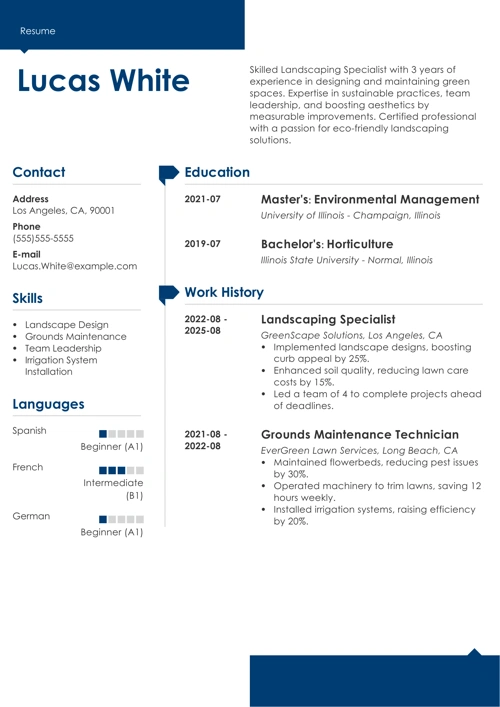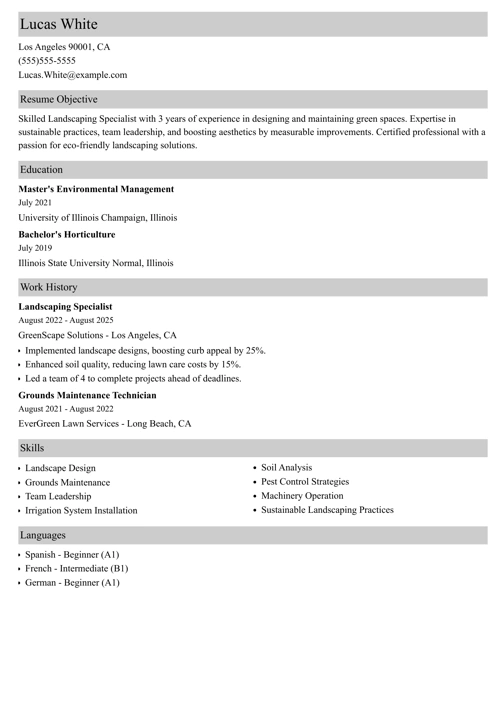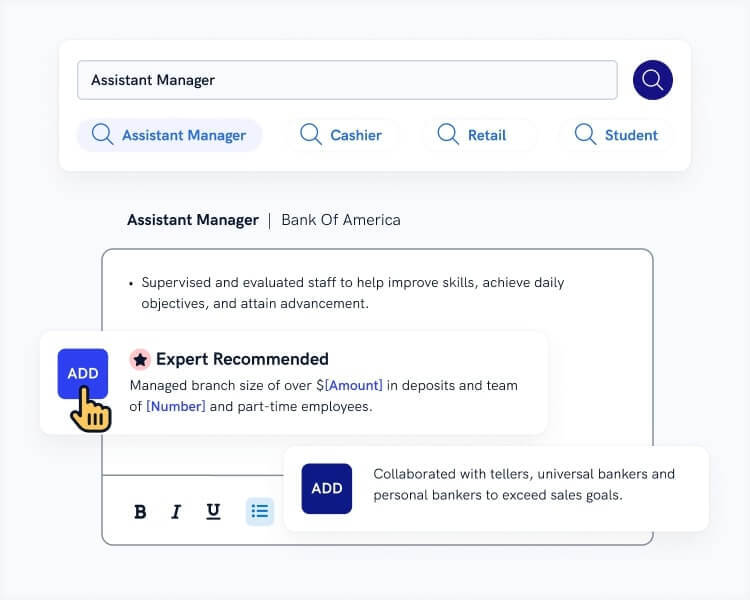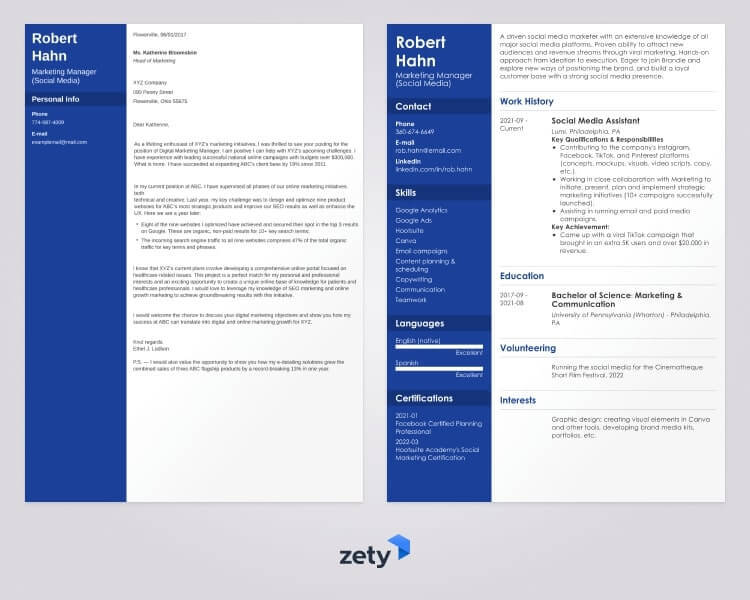With a mix of creativity and good old elbow grease, you have the landscaping skills to turn a bare patch of earth into a thing of beauty.
You don’t want to be stuck mowing lawns, you want a landscaper career that’ll let your skills and creativity shine.
But to get the best landscaping gigs you’ve got to prove you’re the cream of the crop. Sow the seeds of landscaping job success with a landscaping resume as good as the one below.
This guide will show you:
- A general landscape resume example better than 9 out of 10 other resumes.
- How to write a landscaping resume that will land you more interviews.
- Tips and examples of skills for landscaping resume.
- How to describe your experience on a landscape resume to get any job you want.
Want to save time and have your resume ready in 5 minutes? Try our resume builder. It’s fast and easy to use. Plus, you’ll get ready-made content to add with one click. See 20+ resume templates and create your resume here.
Sample resume made with our builder—See more resume samples here.
Considering similar jobs? See these related resume guides.
- Landscape Architecture Resume Sample
- General Labor Resume Sample
- Construction Resume Sample
- Handyman Resume Sample
- Architecture Resume Sample
- Contractor Resume Sample
- Maintenance Worker Resume Sample
- Maintenance Technician Resume Sample
- Housekeeping Resume Sample
- Best Resume Samples
Sample Landscaping Resume Template
Lucas White
lucaswhitezety@gmail.com
304-4332-158
Professional Summary
Landscape technician with 3+ years of experience. Dedicated to maintaining existing landscapes and designing new ones with a focus on meeting client requirements and budgetary constraints. Specialize in creating low maintenance gardens that reduce clients’ water use by an average of 30% and significantly reduce upkeep costs. Looking to make use of my skills to create beautiful and cost-effective projects for Groundforce Landscaping Pros.
Work Experience
West Charleston Landscaping Services, Charleston, WV
Landscape Technician
March 2016–Present
- Performed upkeep of existing landscaping by pruning, trimming, weeding, and gardening. Completed all jobs within allotted times.
- Planted trees, shrubs, perennials, and annuals. Achieved average 10% underspend on budget while still meeting client requirements.
- Experience operating a sod cutter, tiller, and other landscaping machinery with care taken to use appropriate PPE.
- Performed aquascaping, including installation and repair of residential irrigation systems, fountains, and water features.
- Helped maintain profitability by sourcing cost-effective raw materials.
Education
George Washington High School, Charleston, WV
Graduated in 2015
Landscape Design Diploma
Ashworth College, Charleston, WV, 2015
Skills
- Horticultural skills
- Tree management
- Hardscaping
- Aquascaping
- Landscaping machinery operation
- Design drawing skills
- Organizational skills
- Communication skills
Volunteering
- Provided volunteer landscaping services for North Charleston Community Center.
Awards
- Highly Commended, 2019 Charleston in Bloom competition
This is how to write a landscape resume that’ll come up roses.
1. Choose the Best Resume Format for Your Landscaping Resume
A landscaper isn’t just a gardener. They alter earth and water to make a landscape more aesthetically pleasing. The purpose of your landscaping resume is to prove you have the skill to improve an existing garden layout, perhaps including a specialty like aquascape design.
But—
While you’re used to taking a long term view about how a landscape matures, a hiring manager takes only 7 seconds to scan your resume.
To focus their attention you’ve got to follow some resume formatting rules.
- Put your resume contact information first.
- There’s a few types of professional resume formats, but the best is reverse-chronological resume format. It’s the one people are most familiar with and it puts your experience up front where it belongs.
- When writing your landscaping resume, use an attractive, readable resume font and use lots of white space to keep it easy on the eye.
- When you click save, the best resume file type is PDF. It doesn’t mess with your resume layout. You’re a landscaper, I don’t need to tell you how important having things neatly arranged is.
- And how long should a resume be? Keep the writing to a minimum. If you’ve got lots of experience then go ahead and do two pages. Otherwise, stick to one.
Read more: Resume / CV Outline Template
2. Write a Landscape Resume Objective or Resume Summary
They’re like two different color varieties of the same plant. Both are forms of resume profile.
Your profile is a short and sweet little paragraph at the top of your resume. It uses just 3 or 4 sentences to explain why you’re the best choice for the job. It’s what salesmen would call an elevator pitch.
A resume professional summary is best if you have more than 2 years of landscaping experience. Make one like this.
- Take some time to make a list of all your selling points as a landscaper. All of the professional experience, skills and abilities that you’d pitch to a potential customer.
- Then take a look at the job description in the ad and match 3–4 points from your list to the landscaping skills the ad is asking for.
A resume career objective is your go-to if you’re just starting out in the trade or if you’re changing careers. Maybe you’re turning a passion for landscaping into a business.
- Include the landscaping skills you’ve learned so far, any experience you have, and explain how you’d be a good fit for the job.
- Then use some achievements and transferable skills to back that up. Have you done landscaping projects for your own yard or for friends and family? That’ll work perfectly.
In both cases, be sure to write a resume profile that’s targeted to the job ad. All jobs are different, and your resume should reflect that.
Let’s keep digging. Time to get your hands dirty with your work experience section.
Learn all the ins and outs of starting a resume successfully: How to Start a Resume?
3. Sculpt a Perfect Landscaping Job Description
Your resume experience section needs to have the charm of a well-placed water feature.
- Use reverse-chronological order for this section. Your most recent job goes first and you work backward from there.
- For each entry, include your job title, your employer’s name, dates of employment (use “present” as the end date if you work there now), then up to six bullet points describing the job.
- Include the most details for more recent jobs. You can be briefer for older positions, but always stay relevant to the job you’re applying for.
- Speaking of older positions, how far back should a resume go? A good rule of thumb is 10-15 years.
- Start your bullet points with a resume action word to give them maximum impact.
- Write about measurable professional achievements, not just duties. It’s not just about what you do but about how well you do it.
- Target your resume work experience section to the job description.
Pro Tip: What if you’re writing a resume with no experience? You can get some by doing landscaping for friends and family. Or get some paid gigs through old school classified ads, or online freelancing services like Upwork.
4. Include a Landscaping Resume Education Section
Sure, you don’t need a PhD from Princeton to be a great landscaper, but if you’ve got some landscaping education it’s a sure-fire win on your resume.
- If you’ve been in the workforce for more than five years then just list your education. For high school that means the name of the school, city, state, and graduation year. If you went to college it’s the college name, years attended, and degree with major and minors.
- If you’ve got a landscaping certificate or diploma, include the name of the institution, the name of the certificate and the year you received it.
- If you’ve only just finished school, or just completed training, put more detail in your resume education section. List your achievements then match them to the job description. Aced your hardscaping module? This is the place to boast about it.
- If you’re writing a resume with very little experience then put your education section before your work experience section. That way you show off your strengths first.
Read more: High School on a Resume and Degree on a Resume
5. Show off Your Landscaping Resume Skills
What are the best skills for landscaping resume? Good landscape rests on a wide set of skills. Here’s how to incorporate them into your resume.
- Time to brainstorm another list. This time it’s your job skills. Include anything that’s relevant, selecting from soft skills, hard skills, and technical skills.
- Select landscaping skills for resume. Match the list to the job description and include the ones that are relevant. Also, make sure you incorporate the skills into your experience and education sections. That helps prove you’ve got what it takes.
Landscaping Skills for Resume Examples
- Horticultural skills
- Tree management.
- Lawn care
- Hardscaping
- Aquascaping
- Landscaping machinery operation
- Design drawing skills
- Problem solving skills
- Interpersonal skills
- Technical skills
- Creative thinking skills
- Organizational skills
- Time management skills
- Communication skills
- Project management skills
We’ve analyzed over 11 million resumes created using our builder, and we’ve discovered that:
- Landscapers usually list 28 skills on their resumes.
- The most common skills for Landscapers include self-motivation, customer service, multitasking, transplanting and potting plants, and stonework.
- Resumes for Landscapers are, on average, 2 pages long.
Making a resume with our builder is incredibly simple. Follow our step-by-step guide, use ready-made content tailored to your job and have a resume ready in minutes.
When you’re done, our professional resume builder will score your resume and our ATS resume checker will tell you exactly how to make it better.
6. Add Extra Sections to Your Landscaping Resume
Now that you know what skills for landscaping resume will work best, it's time for something extra. Sometimes a final touch like a carefully arranged garden border can be key to a successful landscaping project. For a resume, the final touch is adding extra sections.
- Language skills are great because they’re highly sought after in jobs where you work directly with customers.
- Also include projects, achievements, awards, hobbies, volunteering. Anything that’ll help you stand out for the job.
Volunteering is a big one. Don’t just take my word for it, 82% of hiring managers prefer to employ people with volunteering experience.
7. Attach a Cover Letter to Your Landscaping Resume
Are cover letters necessary? You bet they are. Almost half of hiring managers will reject an application that doesn’t include a cover letter.
These tips will make sure you write it well.
- Use a well constructed and effective cover letter format.
- Write a cover letter introduction with a “hook” that’ll keep them reading.
- Prove your experience will help to craft incredible landscaping projects and always stay targeted to the job.
- Include a cover letter ending with an offer to help meet the needs of your employer and a call to action.
- How long should a cover letter be? Make it around 200-400 words long.
Pro Tip: Follow up on your job application. It might feel awkward, but an email or phone call is expected of you.
Plus, a great cover letter that matches your resume will give you an advantage over other candidates. You can write it in our cover letter builder here. Here's what it may look like:
See more cover letter templates and start writing.
That’s it—
You’ve learned how to prepare the ground for a perfect landscape resume.
About Zety’s Editorial Process
This article has been reviewed by our editorial team to make sure it follows Zety's editorial guidelines. We’re committed to sharing our expertise and giving you trustworthy career advice tailored to your needs. High-quality content is what brings over 40 million readers to our site every year. But we don't stop there. Our team conducts original research to understand the job market better, and we pride ourselves on being quoted by top universities and prime media outlets from around the world.




